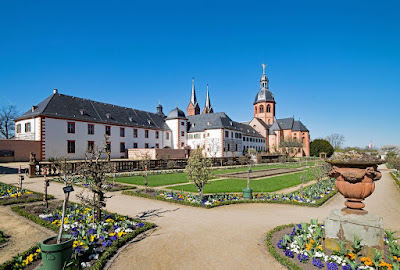The Monastery in Seligenstadt and its garden
Our small town Babenhausen has a lot to offer, although it may not seem like it. However, we would like to teach you more about our surroundings. That is the reason why we have written a text about the monastery in Seligenstadt.
Seligenstadt has many other sights, of course, but this one especially stands out. We thought it would also fit perfectly with our shared topic, nature. Anyone interested in historical development and plants is invited to read on.
 |
|
The Basilika of Seligenstadt https://commons.wikimedia.org/wiki/File:Seligenstadt_Basilika.jpg, Creative Commons Attribution-Share Alike 3.0 Unported |
The Seligenstadt monastery with its museum showrooms and varied gardens is a special place to learn and collect experience for groups of all ages. The garden, the pharmacy, the cloister, dining room and the monastery kitchen offer an incredible view of the past.
The Seligenstadt monastery was a Benedictine abbey, which existed from the 9th to the 19th century. Benedictines are referred to in a broader sense as religious people who live according to the Regula Benedicti (in a narrower sense member of communities belonging to the Benedictine Confederation, a contemplative order within the Roman Catholic Church, established in 1893). The Benedictine order invokes Benedict of Nursia and the rule assigned to him.
A visit to the former Benedictine abbey gives an impressive insight into monastic life according to this order. If possible, the monastery should be laid out in such a way that everything necessary, namely water, mill and garden, is located within the monastery and the various types of handicrafts can be practiced there. So the monks wouldn’t have to run around outside.
 |
|
Summer refectory, Picture Stefan Oemisch, https://commons.wikimedia.org/wiki/File:2021_Seligenstadt_Kloster_Sommerspeisesaal.jpg Creative Commons Attribution-Share Alike 4.0 International |
In 1803, however, the time of the Seligenstadt monks ended when ecclesiastical property was secularized under Napoleonic rule and the monastery fell to the Landgraviate of Hesse-Darmstadt. Until the 1960s, the monastery buildings served as the residence of various authorities.
In the 1980s, the Hessian palace administration began restoring the monastery complex in the sense of its last heyday in the 17th and 18th centuries. The convent garden was also reconstructed in its baroque structure and planting.
Today a third of the whole area is being used for growing plants, vegetables, fruits and herbs like artichokes, pear- apple and cherry trees, strawberries, lavender, roses, sage, mint, rosemary, thyme and a lot more. Flowers, espalier fruits and dye plants are cultivated along the monastery wall.
In each season the monastery plants any vegetables, fruit, flowers etc., that bloom/thrive and represent the right season at that time. For example, there is a big and fenced area where they would plant different colored tulips in spring. In sommer there would be high trees with a lot of cherrys hanging from them. In autumn pears and apples get sold at the entries and lastly, in winter snowdrops get planted, so that they can bloom in spring.
Although you can enter other parts of the monastery, such as the museum, the garden is closed in winter. At this time the workers prepare the ground for the next year and take care of the winter hardy plants.
In addition, various guided tours are offered and it is possible to rent the beauty of the garden and hall for your own purposes. Such as birthdays or weddings.
 |
|
The gardens, picture: lapping, https://pixabay.com/de/photos/seligenstadt-hessen-deutschland-2190576/ |
No comments:
Post a Comment